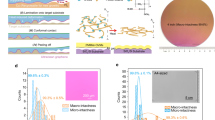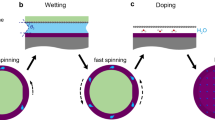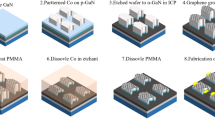Abstract
Graphene has attracted worldwide interest since its experimental discovery1,2, but the preparation of large-area, continuous graphene film on SiO2/Si wafers, free from growth-related morphological defects or transfer-induced cracks and folds, remains a formidable challenge3. Growth of graphene by chemical vapour deposition on Cu foils4,5,6,7 has emerged as a powerful technique owing to its compatibility with industrial-scale roll-to-roll technology6. However, the polycrystalline nature and microscopic roughness of Cu foils means that such roll-to-roll transferred films are not devoid of cracks and folds6,7. High-fidelity transfer or direct growth of high-quality graphene films on arbitrary substrates is needed to enable wide-ranging applications in photonics or electronics, which include devices such as optoelectronic modulators, transistors, on-chip biosensors and tunnelling barriers3,8,9. The direct growth of graphene film on an insulating substrate, such as a SiO2/Si wafer, would be useful for this purpose, but current research efforts remain grounded at the proof-of-concept stage, where only discontinuous, nanometre-sized islands can be obtained10. Here we develop a face-to-face transfer method for wafer-scale graphene films that is so far the only known way to accomplish both the growth and transfer steps on one wafer. This spontaneous transfer method relies on nascent gas bubbles and capillary bridges between the graphene film and the underlying substrate during etching of the metal catalyst, which is analogous to the method used by tree frogs to remain attached to submerged leaves11,12. In contrast to the previous wet4,5,13,14,15 or dry6,7 transfer results, the face-to-face transfer does not have to be done by hand and is compatible with any size and shape of substrate; this approach also enjoys the benefit of a much reduced density of transfer defects compared with the conventional transfer method. Most importantly, the direct growth and spontaneous attachment of graphene on the underlying substrate is amenable to batch processing in a semiconductor production line, and thus will speed up the technological application of graphene.
This is a preview of subscription content, access via your institution
Access options
Subscribe to this journal
Receive 51 print issues and online access
$199.00 per year
only $3.90 per issue
Buy this article
- Purchase on Springer Link
- Instant access to full article PDF
Prices may be subject to local taxes which are calculated during checkout




Similar content being viewed by others
References
Novoselov, K. S. et al. Electric field effect in atomically thin carbon films. Science 306, 666–669 (2004)
Novoselov, K. S. et al. Two-dimensional atomic crystals. Proc. Natl Acad. Sci. USA 102, 10451–10453 (2005)
Novoselov, K. S. et al. A roadmap for graphene. Nature 490, 192–200 (2012)
Li, X. S. et al. Large-area synthesis of high-quality and uniform graphene films on copper foils. Science 324, 1312–1314 (2009)
Gao, L. B. et al. Efficient growth of high-quality graphene films on Cu foils by ambient pressure chemical vapor deposition. Appl. Phys. Lett. 97, 183109 (2010)
Bae, S. K. et al. Roll-to-roll production of 30-inch graphene films for transparent electrodes. Nature Nanotechnol. 5, 574–578 (2010)
Kang, J. et al. Efficient transfer of large-area graphene films onto rigid substrates by hot pressing. ACS Nano 6, 5360–5365 (2012)
Yang, H. et al. Graphene barristor, a triode device with a gate-controlled Schottky barrier. Science 336, 1140–1143 (2012)
Liu, M. et al. A graphene-based broadband optical modulator. Nature 474, 64–67 (2011)
Chen, J. Y. et al. Oxygen-aided synthesis of polycrystalline graphene on silicon dioxide substrates. J. Am. Chem. Soc. 133, 17548–17551 (2011)
Federle, W., Barnes, W. J. P., Baumgartner, W., Drechsler, P. & Smith, J. M. Wet but not slippery: boundary friction in tree frog adhesive toe pads. J. R. Soc. Interface 3, 689–697 (2006)
Persson, B. N. J. Wet adhesion with application to tree frog adhesive toe pads and tires. J. Phys. Condens. Matter 19, 376110 (2007)
Reina, A. et al. Large area, few-layer graphene films on arbitrary substrates by chemical vapor deposition. Nano Lett. 9, 30–35 (2009)
Kim, K. S. et al. Large-scale pattern growth of graphene films for stretchable transparent electrodes. Nature 457, 706–710 (2009)
Gao, L. B. et al. Repeated growth and bubbling transfer of graphene with millimetre-size single-crystal grains using platinum. Nature Commun. 3, 699 (2012)
Li, X. S. et al. Large-area graphene single crystals grown by low-pressure chemical vapor deposition of methane on copper. J. Am. Chem. Soc. 133, 2816–2819 (2011)
Sun, Z. Z. et al. Growth of graphene from solid carbon sources. Nature 468, 549–552 (2010)
Levendorf, M. P. et al. Graphene and boron nitride lateral heterostructures for atomically thin circuitry. Nature 488, 627–632 (2012)
Rafiee, J. et al. Wetting transparency of graphene. Nature Mater. 11, 217–222 (2012)
Bunch, J. S. et al. Impermeable atomic membranes from graphene sheets. Nano Lett. 8, 2458–2462 (2008)
Kobayashi, H., Mizokuro, T., Nakato, Y., Yoneda, K. & Todokoro, Y. Nitridation of silicon oxide layers by nitrogen plasma generated by low energy electron impact. Appl. Phys. Lett. 71, 1978–1980 (1997)
Gao, L. B., Ren, W. C., Li, F. & Cheng, H. M. Total color difference for rapid and accurate identification of graphene. ACS Nano 2, 1625–1633 (2008)
Janos, S. Colorimetry: Understanding the CIE System 25–88 (Wiley, 2007)
Greenwood, J. A. & Williamson, J. B. P. Contact of nominally flat surfaces. Proc. R. Soc. Lond. A 295, 300–319 (1966)
Persson, B. N. J. Capillary adhesion between elastic solids with randomly rough surfaces. J. Phys. Condens. Matter 20, 315007 (2008)
Ferrari, A. C. et al. Raman spectrum of graphene and graphene layers. Phys. Rev. Lett. 97, 187401 (2006)
Das, A. et al. Monitoring dopants by Raman scattering in an electrochemically top-gated graphene transistor. Nature Nanotechnol. 3, 210–215 (2008)
Gao, L. B. et al. Surface and interference coenhanced Raman scattering of graphene. ACS Nano 3, 933–939 (2009)
Wei, D. C. et al. Synthesis of N-doped graphene by chemical vapor deposition and its electrical properties. Nano Lett. 9, 1752–1758 (2009)
Yoon, T. et al. Direct measurement of adhesion energy of monolayer graphene as-grown on copper and its application to renewable transfer process. Nano Lett. 12, 1448–1452 (2012)
Acknowledgements
We thank C. T. Nai for help with X-ray photoelectron spectroscopy and B. K. Chong (Agilent Technologies) for the liquid AFM. This work was supported by MOE Tier 2 grant ‘Interface engineering of graphene hybrids for energy conversion’ (R-143-000-488-112) and by NRF-CRP grant ‘Novel 2D materials with tailored properties: beyond graphene’ (R-144-000-295-281).
Author information
Authors and Affiliations
Contributions
L.G. and K.P.L. designed the experiments, interpreted the data and wrote the manuscript. L.G. performed graphene growth, transfer and calculations. L.G., G.-X.N. and B.L. fabricated the devices. Y.L. performed the X-ray photoelectron spectroscopy measurements. L.G., K.P.L. and A.H.C.N. discussed the data.
Corresponding author
Ethics declarations
Competing interests
The authors declare no competing financial interests.
Supplementary information
Supplementary Information
This file contains Supplementary Text and Data 1-8, Supplementary Figures 1-11 and additional references. (PDF 1190 kb)
Rights and permissions
About this article
Cite this article
Gao, L., Ni, GX., Liu, Y. et al. Face-to-face transfer of wafer-scale graphene films. Nature 505, 190–194 (2014). https://doi.org/10.1038/nature12763
Received:
Accepted:
Published:
Issue Date:
DOI: https://doi.org/10.1038/nature12763
This article is cited by
-
The Effect of Pressure on the Growth of Single-Layer Graphene on Copper Sheets by Chemical Vapor Deposition Methods
Journal of Materials Engineering and Performance (2024)
-
Towards growth of pure AB-stacked bilayer graphene single crystals
Nano Research (2024)
-
Highly stable integration of graphene Hall sensors on a microfluidic platform for magnetic sensing in whole blood
Microsystems & Nanoengineering (2023)
-
Stamped production of single-crystal hexagonal boron nitride monolayers on various insulating substrates
Nature Communications (2023)
-
Stacking transfer of wafer-scale graphene-based van der Waals superlattices
Nature Communications (2023)
Comments
By submitting a comment you agree to abide by our Terms and Community Guidelines. If you find something abusive or that does not comply with our terms or guidelines please flag it as inappropriate.



